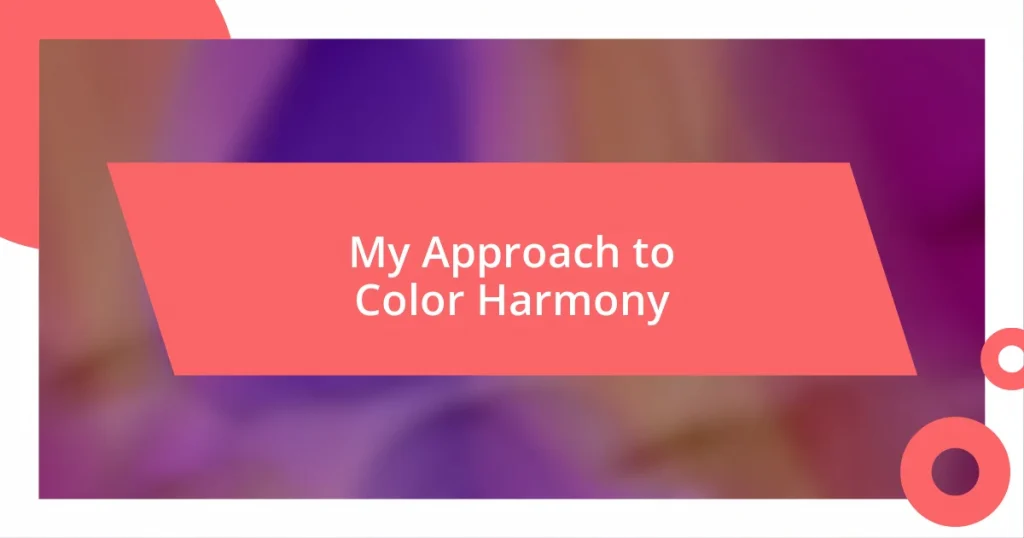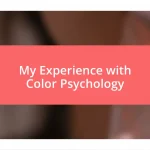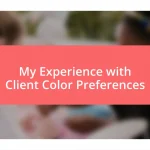Key takeaways:
- Color theory emphasizes the emotional and psychological impact of colors, guiding design choices to create desired atmospheres and connections.
- The color wheel is a fundamental tool for understanding color relationships, including primary, secondary, tertiary, and various harmony types (analogous, complementary, triadic).
- Common mistakes in color selection include using too many colors, neglecting contrast, and failing to consider the target audience, which can significantly affect communication and engagement.
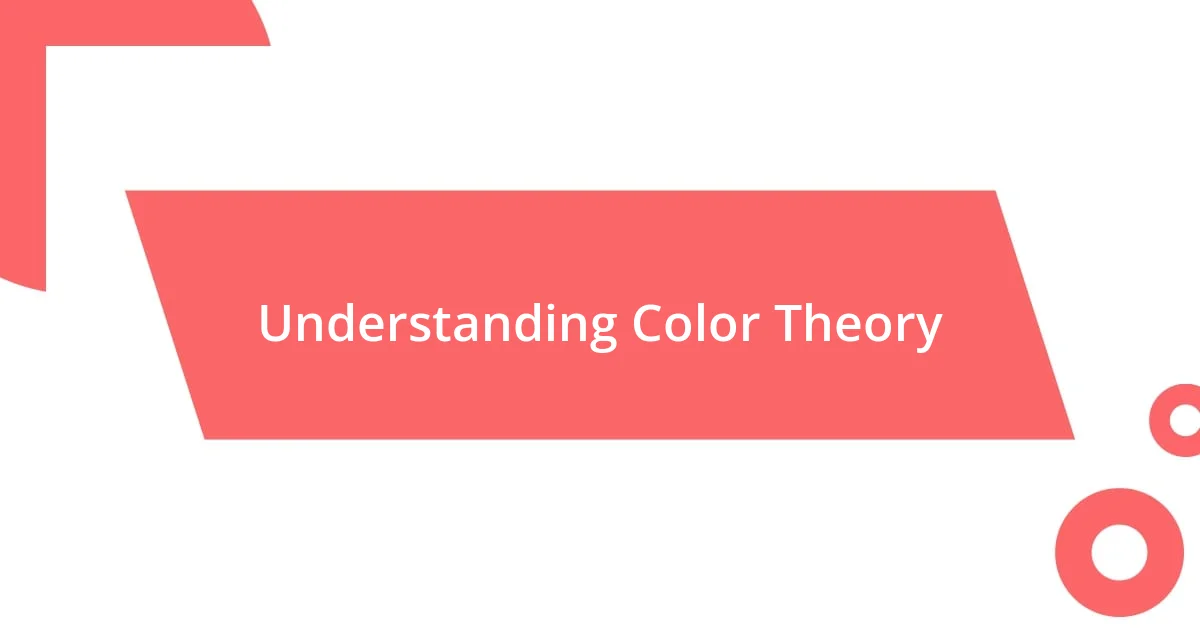
Understanding Color Theory
Color theory is the backbone of understanding how colors interact with each other. I still vividly remember the first time I experimented with mixing paints as a child; the thrill of seeing a vibrant blue transform into a stunning green was nothing short of magical. It made me realize that colors aren’t just visual sensations—they evoke emotions and tell stories.
When exploring the color wheel, it becomes clear that the relationships between colors can create harmony or tension. I often ponder, how can one shade draw attention while another recedes into the background? The answer lies in complementary colors—they sit opposite each other on the wheel, like a dance of contrasts. I find that using these pairs strategically can instantly elevate a design, making it visually striking and emotionally resonant.
Moreover, understanding the psychological impact of colors has profoundly influenced my approach. For instance, if I want to evoke calmness, I reach for soft blues and greens. This isn’t just about aesthetics; it’s about creating an atmosphere that resonates with how we feel. Have you ever noticed how a bright, warm color can instantly uplift your mood? That’s the power of color theory at play, and it’s mind-blowing how it can anchor our emotional experiences.
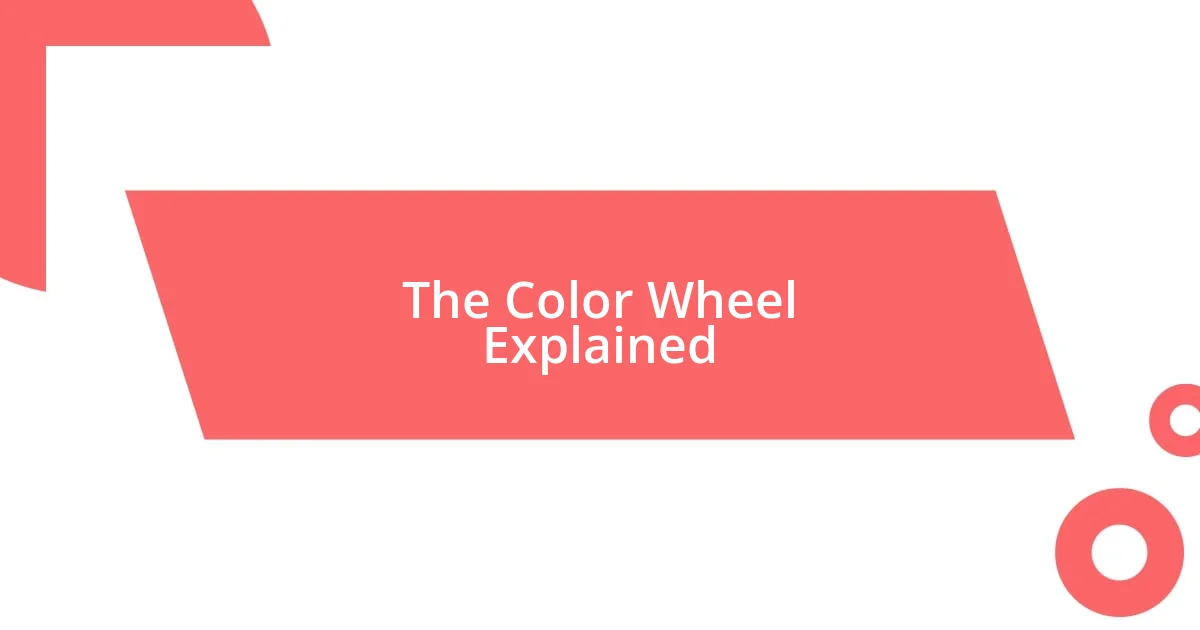
The Color Wheel Explained
The color wheel is a powerful visual tool that helps us understand the relationships between colors. I still remember sitting with my art teacher, mesmerized as she explained primary, secondary, and tertiary colors. Primary colors—red, blue, and yellow—are the building blocks, while secondary colors—green, orange, and purple—are created by mixing them. This foundational knowledge opens a door to endless possibilities and creativity.
- Primary Colors: Red, Blue, Yellow
- Secondary Colors: Green (Yellow + Blue), Orange (Red + Yellow), Purple (Red + Blue)
- Tertiary Colors: Created by mixing a primary color with a neighboring secondary color (like red-orange).
I often find myself flipping back to the color wheel when I feel stuck in my creative process. It’s like a compass that guides me, helping me pick harmonious shades that resonate with my emotions. For instance, when I’m designing a cozy space, I lean towards warm, analog colors, such as oranges and yellows, because they remind me of laughter and sunlight filtering through autumn leaves. This emotional connection transforms my work from mere aesthetics into a vivid story that reflects my experiences.
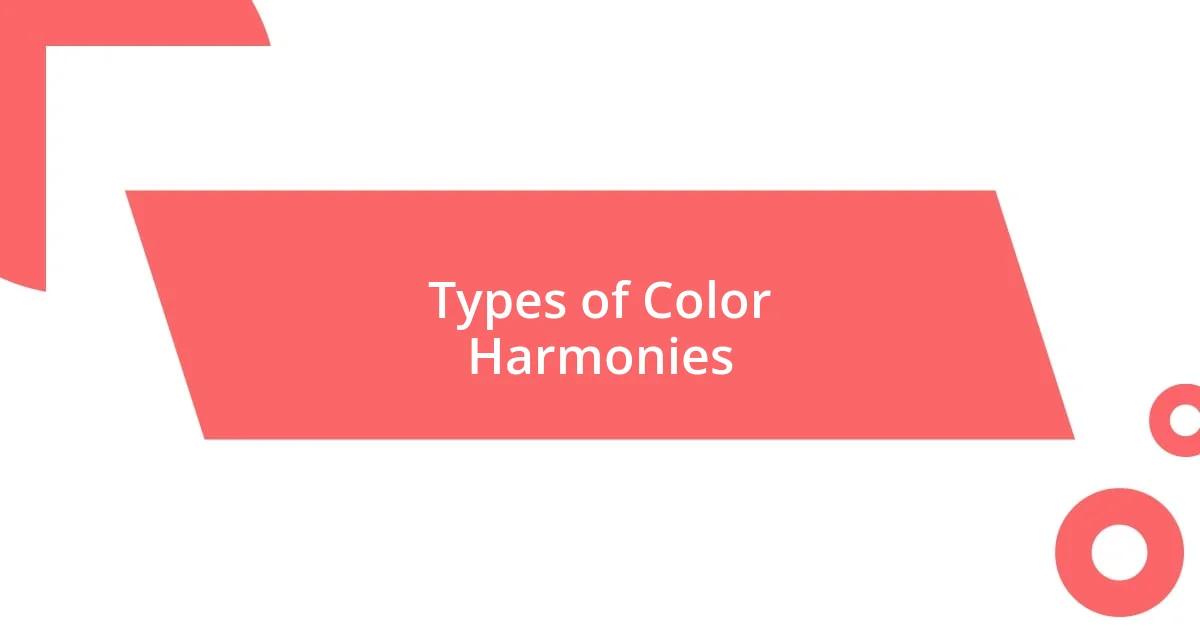
Types of Color Harmonies
When I think about types of color harmonies, a few key categories come to mind that can dramatically impact a design. The three main types are analogous, complementary, and triadic harmonies. Each style offers a unique way to convey feelings or set a mood. For instance, I often use analogous colors, which sit next to each other on the color wheel, when I want to create a serene and cohesive look. I’ve noticed that these combinations, such as blue, teal, and green, can transport me to calm beaches or tranquil gardens.
Complementary color schemes, on the other hand, are where the real magic happens. These colors, found opposite each other on the color wheel, create striking contrasts that can grab attention. I remember once designing a poster with vibrant orange and deep blue. The way those colors danced together was electric, highlighting the message in a way that was both uplifting and engaging. It was a vivid reminder of how opposites can really enhance each other.
Then there’s the triadic harmony, which involves three evenly spaced colors on the color wheel. I love to play with these combinations because they add balance and visual interest, creating a dynamic yet harmonious effect. A project that stands out to me was when I used red, yellow, and blue for a children’s mural. Those colors sang with joy and energy, drawing children in and sparking their imaginations. This experience solidified my belief that understanding these types of color harmonies empowers us to evoke specific emotions and create connections with our audience.
| Type of Color Harmony | Description |
|---|---|
| Analogous | Colors that are next to each other on the color wheel, creating a serene, cohesive look. |
| Complementary | Colors opposite each other on the color wheel, providing striking contrasts for high visual impact. |
| Triadic | Three evenly spaced colors on the color wheel, offering balance and vibrancy. |
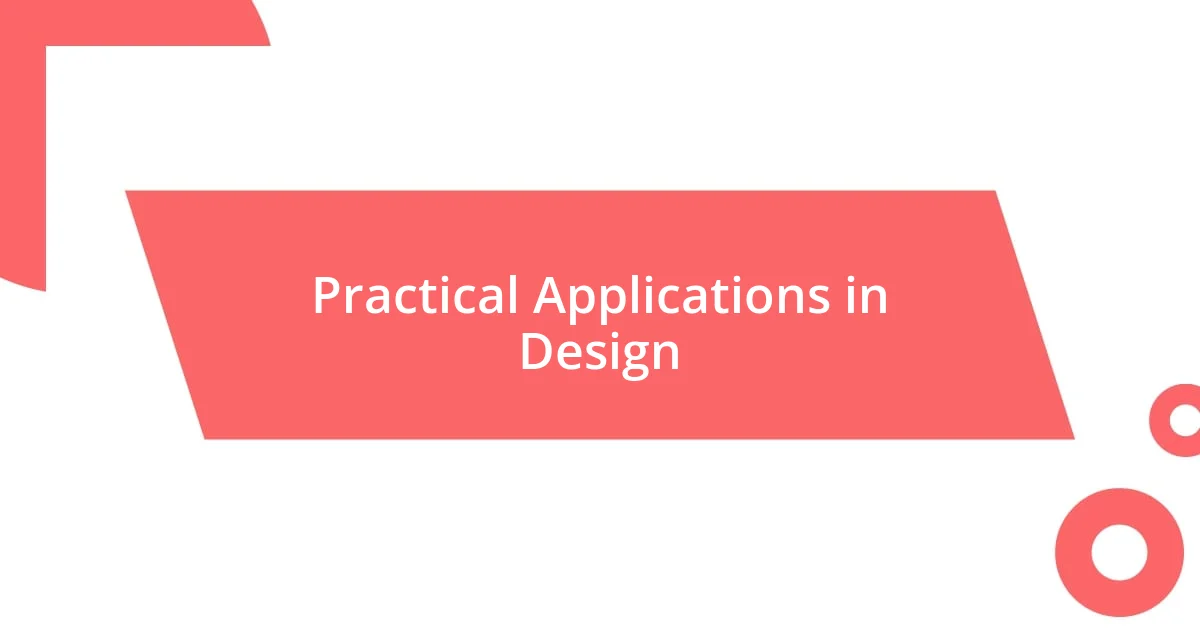
Practical Applications in Design
When I dive into practical applications of color harmony in design, I often reflect on my past projects. For instance, while designing a community garden flyer, I embraced an analogous scheme with greens and yellows. The result was a vibrant, inviting look that perfectly captured the essence of growth and community spirit. Have you ever noticed how certain color combinations can elevate your mood? It’s incredible how a simple choice can transform a piece entirely.
I also find that color harmony plays a significant role in web design. Once, I had to create a website for a local café, and I opted for a triadic color scheme featuring soft coral, sage green, and muted lavender. This balance not only made the site visually appealing but also cohesive, guiding visitors gently through the experience. Have you ever visited a site that felt so seamlessly put together? It’s likely that the designer was intentional with their color choices.
One memorable moment came when I experimented with complementary colors for a client’s branding project. Using a bold red paired with a cool teal, I created a logo that didn’t just stand out—it practically demanded attention. The finished product sparked excitement in the client, reinforcing my belief that the right colors can create magnetic energy. What colors have grabbed your attention lately? It’s a reminder that in design, color harmony isn’t just theory—it’s about making connections and leaving lasting impressions.
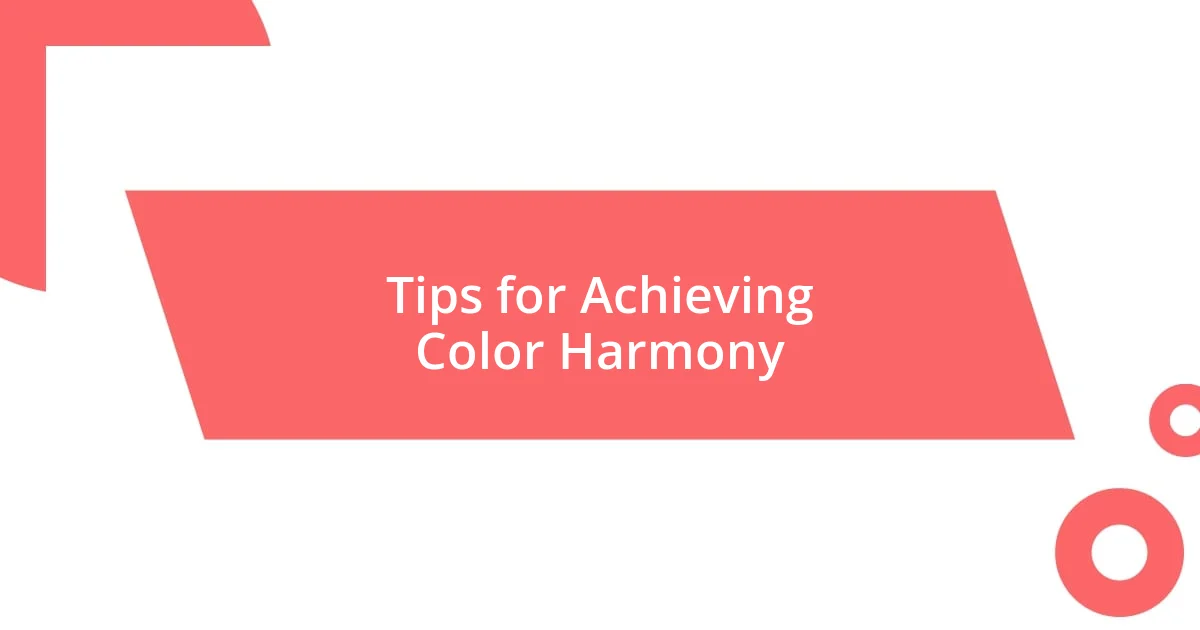
Tips for Achieving Color Harmony
To achieve color harmony, I’ve always found that understanding the emotional weight of colors is crucial. For example, consider how you feel when you see a blend of soft pastels versus bold primaries. I remember crafting a cozy reading nook in my home using a palette of warm beige and gentle pinks, which radiated a sense of comfort and relaxation. In contrast, vibrant red and black created a stylish, energetic space in my kitchen—each choice evoked a different feeling entirely.
One of my favorite tips is to trust your instincts when choosing color combinations. It often comes down to what resonates with you personally. When I was developing a branding concept for a friend’s business, I selected a sunny yellow and muted gray. The cheerful yellow inspired positivity, while the gray grounded the design, creating a harmonious balance that truly reflected my friend’s vision. Have you ever had that moment when a color choice just feels right? Those moments can lead to some of the best creative outcomes.
Lastly, using tools like color wheels or apps can be incredibly beneficial in finding the right harmony. I often use color pairing tools when working on graphic design projects—these resources help me visualize potential combinations before committing. For instance, while designing a brochure for an event, I experimented with various shades of green and blue and landed on a combo that felt vibrant yet relaxing. It was exciting to transform colors on a screen into a cohesive story. So, what tools do you lean on for inspiration? Embracing technology can truly enhance our understanding of color dynamics.
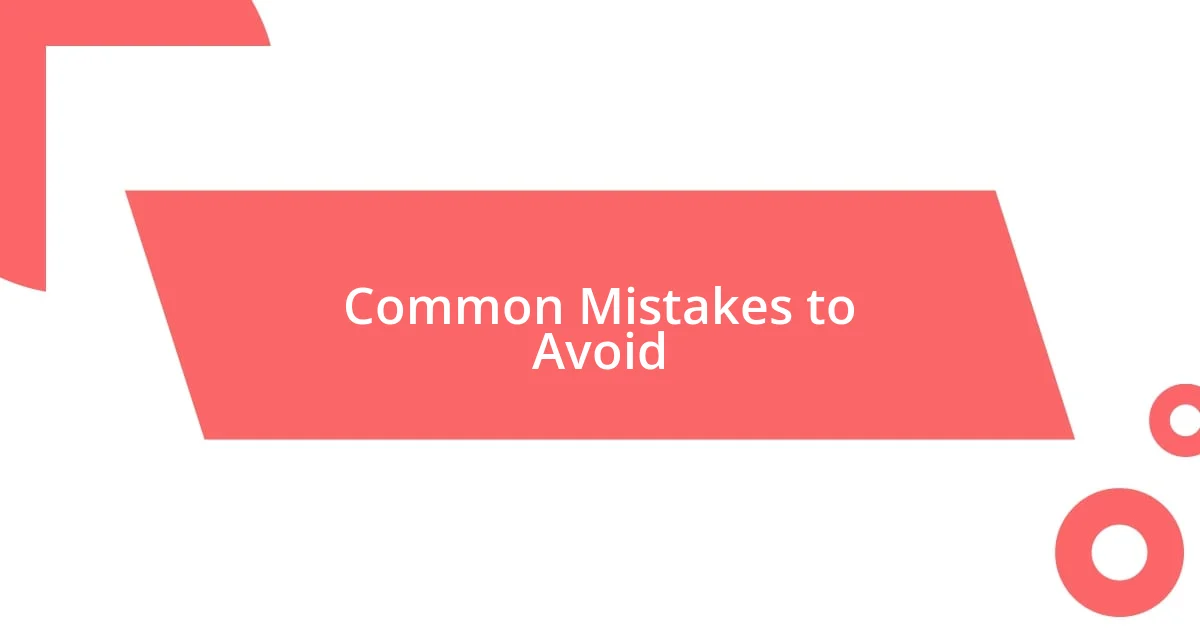
Common Mistakes to Avoid
A common mistake I often see is the overwhelming use of too many colors. Early in my design journey, I made the error of cramming five or six colors into a single piece, thinking it would be visually exciting. Instead, it became chaotic, and the message got lost. Have you ever looked at a design and felt confused by the sheer number of colors? A simpler palette often communicates far more effectively.
Another mistake is neglecting the importance of contrast. I remember a time when I chose a light gray text over a white background for a flyer. It looked sleek in theory, but in practice, it was nearly unreadable. Contrast is key—not just for aesthetics but for ensuring your audience can engage with your message. Have you ever struggled to read something because of poor color choices? It’s frustrating, right?
Lastly, many forget to consider their target audience when selecting colors. During a project for an educational program aimed at children, I initially leaned towards muted shades. After some feedback and reflection, I switched to bright, playful hues. The energy was palpable, and the materials became much more engaging. Have you thought about how color can influence different demographics? Tailoring your color choices to your audience can make all the difference in impact and reception.
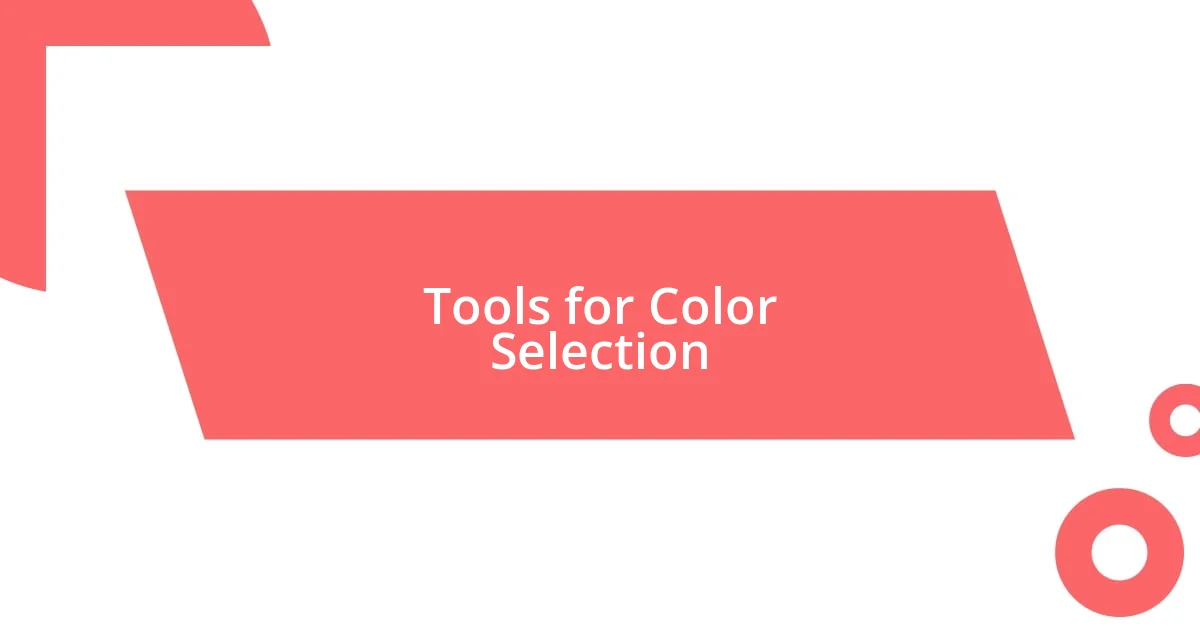
Tools for Color Selection
When it comes to tools for color selection, I often find myself reaching for a trusty color wheel. This simple yet powerful tool visually represents the relationships between colors, making it easier to grasp concepts like complementary or analogous colors. I remember a project where I used the color wheel to create a mural for a community center; I discovered an unexpected harmony between a vibrant purple and a soft yellow, each enhancing the other’s vibrance.
I also adore color palette generators found in various design apps. These tools let me input a base color and, just like magic, generate complementary or contrasting palettes. When I was working on a personal blog redesign, I input a calming teal and was surprised to see warm coral emerge as a standout accent. It wasn’t just eye-catching; it sparked a feeling of coastal tranquility that echoed my vision for the blog. Have you ever found a color palette that felt like it perfectly captured a moment or mood? It’s like stumbling upon a hidden gem!
Lastly, online communities and forums have proven invaluable for seeking fresh perspectives on color choices. Engaging with other designers allows me to see how they interpret color dynamics. During a collaborative project, I shared my initial vibrant palette with peers, who encouraged me to explore more muted tones for sophistication. This exchange not only broadened my color horizons but also reminded me how collaborative insights can significantly impact our creative journeys. What strategies do you use to find inspiration from others? Sometimes, a simple conversation can unlock untapped potential in our work.










